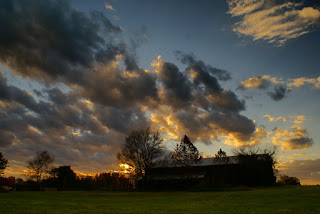By mid-afternoon the day was beginning to heat up, but it
still was not as oppressively hot as it can be in Oklahoma .
Those days were yet to arrive in another few weeks. On this late spring
day, the temperature pushed toward the mid to upper 80’s but the sun was
tempered somewhat by a layer of high thin clouds. Another two hundred yards in
front of me advanced a rocky arroyo that swung in an arching loop that covered
a half mile or more in length and maybe another two hundred yards wide at its
widest. Across its flanks acres of prairie flowers bloomed adding splashes of
red, blue, white, and yellow that blended with the prevailing greenness of the
tall grasses. It was not yet peak season
for the grass and the fields and rolling hills were yet to achieve their
maximum effort of growth. Underfoot, the rocky flint like chert crunched with each step…at times catching the
side of my boot twisting the foot to one side. At the base of the arroyo a
small amount of water trickled and pooled in some of the slower and larger
basins…mostly it was dry. I wiped some of the perspiration from my brow and
walked another fifty yards to the southern edge of the draw where a set of
cedar trees were growing. Their shade offered a fresh respite from the warmth
of the afternoon and the constant Oklahoma
prairie wind provided some cooling relief.
I had discovered this arroyo a year or two before and now it
had become one of my must see hiking places when I am on site. For the most
part, I simply sat in that small patch of cedar tree shade and simply listened
to the sounds of the prairie. Keeping time with the wind prairie birds cast
their chorus and insects added their fluttering drum. The grass swayed and the
cedar trees hummed with each beat of the breeze. The spontaneous rhythm of the
prairie song continued unabated with a new chorus…new rhythm…new words with
each passing moment. With my camera pack propped behind me, I leaned back and
closed my eyes...still weary from the early rise that morning…and the prairie
song fill my soul.
Exploring the tallgrass prairie requires more than simply
driving through and stopping at a scenic overlook. It requires a willingness to
step into it…experience it up close…to feel it underfoot…to hear its song….to
listen to its words. When allowed to speak to you such as this… you then begin
to see what the prairie has to offer photographically. For now it becomes less of a visual capture…and
more of a spiritual understanding that leads to the capturing of its flavor,
strength, serenity, and power. It’s less about what to look for and more about
listening to what it says to you…for it will reveal itself to you and each
revelation is different for each person.
The idea then becomes not to simply photograph a few visual reference
points…but to capture your revelation in such a way that others who see your
work understand why it was important for you. What’s important is not what you
capture…but how you capture it.
I spent most of the afternoon exploring that arroyo until
the sun began to lower toward the horizon. I stopped for a while and watched it
settle before making the hike out before darkness settled in completely. In
hiking the prairie this way, I’ve been able to discover intimate locations that
only the wild bison and prairie birds know about. I think of parts of it as my
person place…a place where I can release the stresses of life and discover a
renewed mind…a place where what once was…still is.


















































